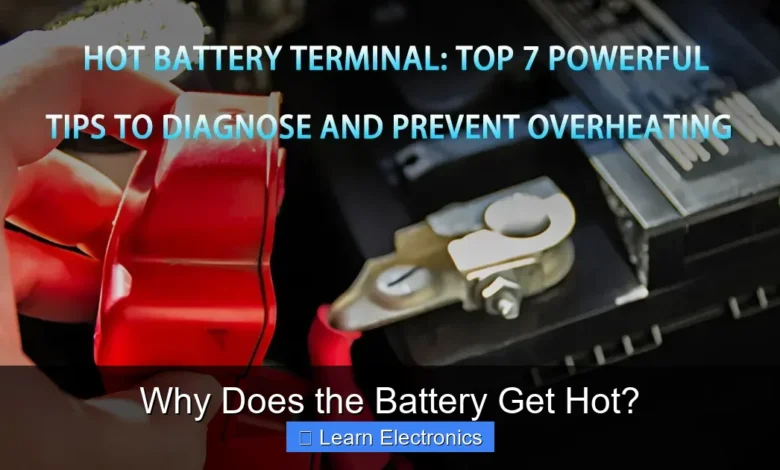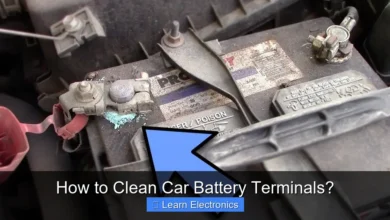Why Does the Battery Get Hot?

Why Does the Battery Get Hot? The primary reason is the conversion of electrical energy into thermal energy due to internal resistance during charging, discharging, or when subjected to external stressors. This energy transformation is a fundamental aspect of battery operation, but excessive heat can indicate underlying problems or inefficient processes. Understanding this phenomenon is crucial for maintaining battery health and safety.
The warming sensation you feel from your phone or laptop battery isn’t always cause for alarm, but recognizing when this method of heat generation becomes problematic is key. Various factors, from electrochemical reactions to environmental conditions, contribute to a battery’s temperature fluctuations, influencing its performance and longevity.
Quick Answers to Common Questions
Why does my phone battery get warm sometimes, is that normal?
Yes, it’s often normal for your battery to get warm, especially during heavy use like gaming or when fast charging. This warmth is usually just a sign the battery is working hard to power your device.
What exactly makes a battery get hot?
A primary reason why the battery gets hot is the internal resistance as electricity flows through it, generating heat. Intensive tasks like streaming or gaming, prolonged charging, or even a weak signal can increase this resistance and the heat produced.
When should I be concerned if my battery is getting hot?
You should be concerned if your battery is consistently extremely hot, starts to swell, emits a strange smell, or causes your device to malfunction. These are signs of a potential problem that needs immediate attention to prevent further damage.
📑 Table of Contents
- The Science Behind Heat Generation: Internal Resistance
- Overcharging and Fast Charging: Pushing the Limits
- External Factors and Environmental Conditions
- Battery Age and Degradation
- Malfunctions and Defects: A Critical Concern
- Mitigation Strategies and Best Practices
- Comparative Table: Factors Influencing Battery Heat
- Conclusion
The Science Behind Heat Generation: Internal Resistance
At the heart of every battery’s operation lies a complex dance of electrochemical reactions, and a natural byproduct of these processes is heat. The fundamental reason why batteries get hot is internal resistance. As electrons flow through the battery’s components – the electrolyte, separator, and electrodes – they encounter resistance. This resistance impedes the free flow of charge, causing some of the electrical energy to be converted into thermal energy, a process known as ohmic heating or Joule heating.
Ohmic Heating Explained
Ohmic heating is governed by Joule’s first law, which states that the power dissipated as heat in a conductor is proportional to the square of the current and the resistance (P = I²R). In a battery, as current (I) flows during charging or discharging, and internal resistance (R) is present, heat (P) is inevitably generated. Higher currents or increased internal resistance directly lead to more significant heat generation. This effect is particularly pronounced during rapid charging or heavy discharge cycles, where large currents are involved.
Factors Affecting Internal Resistance
Several factors contribute to a battery’s internal resistance:
- Electrolyte Conductivity: The ability of the electrolyte to conduct ions. A less conductive electrolyte means higher resistance.
- Electrode Material and Structure: The type and porosity of the electrode materials influence how easily ions can intercalate and deintercalate.
- Separator Properties: The separator must allow ion flow while preventing electronic short circuits; its characteristics affect overall resistance.
- Temperature: Extremely low temperatures can increase internal resistance, leading to less efficient operation and, paradoxically, more heat generation when current is drawn. High temperatures also affect electrolyte stability and electrode integrity over time.
- State of Charge (SOC): Internal resistance can vary with the battery’s SOC, often increasing at very low or very high charge levels.
Managing these factors is critical for battery designers to minimize heat and maximize efficiency.
Overcharging and Fast Charging: Pushing the Limits
While internal resistance is a constant factor, certain charging behaviors can dramatically exacerbate heat generation. Overcharging and fast charging are two common culprits that push a battery beyond its optimal thermal boundaries, accelerating its degradation and potentially posing safety risks.
The Dangers of Overcharging
Overcharging occurs when a battery continues to receive current after reaching its full capacity. Modern devices typically have built-in charge controllers to prevent this, but if these fail or if using a generic, unregulated charger, overcharging can happen. When a battery is overcharged, the excess electrical energy has nowhere to go but to be converted into heat. This causes the electrolyte to decompose, generating gases and increasing internal pressure. This process not only heats the battery but can also lead to swelling, venting, or, in extreme cases, thermal runaway, which can result in fire or explosion, which is a major concern when a battery gets hot.
Fast Charging’s Thermal Demands
Fast charging technologies are designed to replenish battery capacity quickly, but this convenience comes at a thermal cost. To charge rapidly, a charger delivers a higher current to the battery. As per Joule’s law (P = I²R), a higher current (I) squared significantly amplifies heat generation. While modern fast-charging systems incorporate sophisticated thermal management to mitigate this, consistent and aggressive fast charging can still put undue stress on the battery’s components, leading to elevated temperatures. The practice can accelerate the breakdown of the electrolyte and electrode materials, reducing the battery’s overall lifespan.
External Factors and Environmental Conditions
Beyond the internal workings and charging habits, the environment in which a battery operates plays a significant role in its temperature. External factors can either help dissipate heat or trap it, leading to uncomfortable and potentially damaging temperature increases.
High Ambient Temperatures
Operating or charging a battery in a hot environment directly contributes to its temperature. If the ambient temperature is already high, the battery’s internal heat generation has less of a temperature differential to dissipate against. This means the battery will quickly reach and maintain a higher overall temperature. Leaving devices in direct sunlight, in a hot car, or near heat sources can push the battery’s temperature beyond safe operating limits, accelerating degradation and increasing the risk of malfunction. It’s a key consideration for addressing why a battery gets hot unnecessarily.
Poor Ventilation and Physical Damage
A lack of proper ventilation can trap heat around the battery, preventing it from dissipating effectively. This is common in tightly enclosed devices or when a device is used on soft surfaces like beds or couches that block air vents. Furthermore, physical damage to a device or its battery, such as drops or punctures, can compromise its internal structure or thermal management system. Damage can lead to internal short circuits or impaired heat dissipation pathways, causing localized hotspots and overall elevated temperatures. Even a bent or swollen casing can impede the natural cooling process, making the problem worse.
Battery Age and Degradation
Batteries, like all components, age and degrade over time. This natural process significantly impacts their performance and thermal characteristics. An older battery is more prone to generating excessive heat, even under normal operating conditions, making understanding why a battery gets hot a more common concern with aging devices.
Increased Internal Resistance in Aged Cells
As a battery ages, its internal resistance naturally increases. This is due to several factors:
- Electrolyte Degradation: The electrolyte can break down, reducing its ionic conductivity.
- Electrode Material Changes: The active materials on the electrodes can degrade, lose their structural integrity, or form undesirable passive layers (e.g., Solid Electrolyte Interphase – SEI layer growth) that impede ion flow.
- Loss of Active Lithium: Over cycles, some lithium ions become irreversibly trapped, reducing the battery’s capacity and increasing the effective resistance for the remaining active material.
With higher internal resistance, more energy is converted into heat for the same amount of current, making an older battery feel hotter than a new one during equivalent tasks. This phenomenon often manifests as reduced battery life and a noticeable increase in device temperature.
Signs of a Degrading Battery
Beyond increased heat, several signs indicate a battery is degrading:
- Reduced Capacity: The battery holds less charge than it used to.
- Faster Discharge Rate: The device drains power more quickly.
- Inconsistent Performance: Unexpected shutdowns or erratic battery percentage readings.
- Swelling: The battery or device casing appears distended. This is a critical safety concern indicating gas buildup.
- Slower Charging: The battery takes longer to reach full charge, or doesn’t seem to charge fully.
If you observe these signs, especially in conjunction with elevated temperatures, it may be time to consider battery replacement or device servicing.
Malfunctions and Defects: A Critical Concern
While most instances of a warm battery are due to normal operation or environmental factors, sometimes the reason a battery gets hot can be more serious, pointing to internal malfunctions or manufacturing defects. These issues demand immediate attention due to their potential safety implications.
Internal Short Circuits
An internal short circuit occurs when there is an unintended electrical path between the positive and negative terminals inside the battery. This bypasses the normal discharge path, causing a rapid and uncontrolled flow of current within the battery itself. The resistance in this short-circuit path, though often small, can still generate an immense amount of localized heat due to the very high current. This can quickly lead to thermal runaway, where the heat generated by the short circuit further damages the battery, leading to more shorts and even greater heat, culminating in fire or explosion. Internal shorts can be caused by manufacturing defects, physical damage, or dendritic growth in lithium-ion batteries.
Manufacturing Anomalies
Even with rigorous quality control, manufacturing defects can occur. These might include:
- Contaminants: Tiny metal particles or impurities introduced during manufacturing can pierce the separator, leading to microscopic short circuits.
- Improper Welding or Connections: Poorly made internal connections can create points of high resistance, leading to localized heating.
- Separator Damage: A damaged or improperly formed separator can lead to direct contact between electrodes.
- Inconsistent Electrode Coating: Uneven application of active materials can create areas of higher resistance or lead to localized reactions.
Such defects may not manifest immediately but can develop into serious issues over time, making this a critical area of concern when a battery exhibits unusual heating patterns.
Mitigation Strategies and Best Practices
Understanding why your battery gets hot is the first step; the next is implementing strategies to prevent excessive heat and prolong battery life. Adopting good practices can significantly reduce thermal stress and enhance safety.
Optimal Charging Habits
- Avoid Overcharging: Although modern devices have protection circuits, it’s best to unplug your device once it reaches 100%, especially if you notice it feels warm. Avoid leaving devices plugged in overnight if the charger doesn’t manage trickle charging well.
- Moderate Fast Charging: Use fast charging when necessary, but for daily top-ups, a standard charger can be less thermally stressful. Some devices offer settings to optimize battery charging rather than prioritize speed.
- Charge in a Cool Environment: Always charge your device in a well-ventilated, cool area, away from direct sunlight or heat sources.
Environmental Considerations
- Maintain Moderate Temperatures: Avoid exposing devices to extreme temperatures, both hot and cold. Ideal operating temperatures for most batteries are between 0°C and 35°C (32°F and 95°F).
- Ensure Good Ventilation: Do not use devices on soft surfaces that block vents (e.g., beds, couches). Use stands or cases that promote airflow, especially for laptops.
- Remove Cases During Intensive Use: If your device tends to heat up during gaming or other high-demand tasks, remove its protective case to allow for better heat dissipation.
Monitoring and Maintenance
- Monitor Battery Health: Use built-in device tools or third-party apps to monitor battery health and temperature. Pay attention to warnings or significant changes.
- Keep Software Updated: Software updates often include optimizations for power management and thermal regulation.
- Use Original or Certified Chargers: Always use the charger supplied with your device or a certified, reputable alternative to ensure proper voltage and current regulation.
- Avoid Physical Damage: Protect your devices from drops, impacts, and punctures, which can damage the internal battery structure and thermal management.
- Replace Swollen Batteries: If a battery appears swollen, discontinue use immediately and have it professionally replaced. This is a critical safety hazard.
Comparative Table: Factors Influencing Battery Heat
To summarize the various elements discussed, here is a table illustrating how different factors contribute to a battery getting hot, along with potential mitigation strategies:
| Factor | Primary Mechanism of Heat Generation | Impact on Battery | Mitigation Strategy |
|---|---|---|---|
| Internal Resistance | Ohmic heating (I²R) during charge/discharge. | Inherent, but increases with age/degradation. | Use high-quality batteries; avoid deep discharge/charge cycles. |
| Overcharging | Excess energy converted to heat; electrolyte decomposition. | Swelling, thermal runaway, safety risk. | Unplug when fully charged; use smart chargers. |
| Fast Charging | High currents amplify ohmic heating. | Accelerated degradation, reduced lifespan. | Use moderately; ensure device has good thermal management. |
| High Ambient Temp. | Reduced heat dissipation; internal temp builds up. | Accelerated degradation, electrolyte instability. | Operate in cool, well-ventilated areas; avoid direct sun. |
| Poor Ventilation | Trapped heat prevents efficient cooling. | Increased device temperature, uncomfortable use. | Ensure clear air vents; use on hard, flat surfaces. |
| Battery Age/Degradation | Increased internal resistance; inefficient reactions. | Reduced capacity, faster discharge, increased heat. | Replace old batteries; follow optimal charging practices. |
| Internal Short Circuits | Uncontrolled, rapid current flow within battery. | Severe overheating, thermal runaway, fire/explosion. | Handle batteries carefully; replace damaged units immediately. |
Conclusion
Understanding why a battery gets hot involves appreciating a combination of inherent electrochemical processes, user behavior, environmental conditions, and potential underlying faults. While a slightly warm battery during use or charging is often normal, persistent or excessive heat can be a clear indicator of a problem. By recognizing the causes – from the fundamental physics of internal resistance and the demands of fast charging to the impact of aging and the dangers of defects – users can adopt best practices to protect their devices and ensure personal safety. Prioritizing optimal charging habits, maintaining moderate operating temperatures, and promptly addressing signs of battery degradation or malfunction are crucial steps in preventing your battery from getting hot unnecessarily and extending its overall lifespan. Staying informed about this critical aspect of battery care empowers you to use your electronic devices more safely and efficiently.
Frequently Asked Questions
Why do batteries typically get warm during use?
All batteries generate some heat due to internal resistance as chemical reactions produce electrical energy. This is a normal part of their operation, especially during charging, discharging, or when under heavy load.
When should I be concerned if my battery gets hot?
While some warmth is normal, excessive or sudden heat is a cause for concern. If your battery feels too hot to touch, is bulging, or emits a strange odor, it could indicate an internal fault or damage.
What external factors can make a battery get hot?
External factors such as high ambient temperatures, direct sunlight, or being placed in a confined space can significantly contribute to a battery’s temperature rise. Overcharging with an incompatible charger can also lead to dangerous overheating.
What are the risks of a battery getting too hot?
An excessively hot battery can suffer permanent damage, leading to reduced lifespan and performance. In extreme cases, overheating can cause thermal runaway, potentially resulting in fire or explosion, especially with lithium-ion batteries.
How can I prevent my battery from getting too hot?
To prevent overheating, avoid exposing your device to direct sunlight or hot environments. Use only original or certified chargers and ensure adequate ventilation around the device during charging or heavy use.
What should I do if I notice my battery is currently getting hot?
Immediately disconnect the device from its charger and stop using it. If possible and safe, remove the battery. Place the device or battery in a cool, non-flammable location and contact the manufacturer or a service center if the heat persists.



